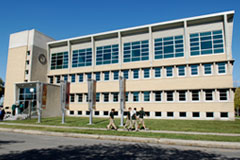Architecture
Architecture is a fine art devoted to the design of the human environment. The architect is concerned with the aesthetic, social, environmental, technological and psychological factors that influence the design of a building. Architects are involved in the success, quality and appearance of a building within the context of a community and the city. Architecture is a dynamic profession that ranges from residential houses to large-scale urban buildings. An architect can design houses, commercial buildings, museums, college science buildings, and resorts, as well as many other building types.
Background Information
To become an architect, you must learn to make use of science and technology, and develop sensitivity for beauty in the design of space and form with material. You must develop a deep understanding of people and their surroundings. Because this work encompasses so many different fields of interest, the architect is best thought of as a professional who bridges different areas of study and blends them into a single, significant activity.
Career Opportunities
Architects work in architectural firms or accept positions with government, corporations or institutions. Some architects become highly specialized; others remain generalists in the profession, working on all facets of a project. Whichever path your career may follow, it is necessary to first build a firm background that includes essential architectural knowledge and skills. Architecture provides a variety of interesting positions within the discipline. One can either work for an established architecture firm or create their own business. There are three typical areas in architecture which one can focus on (or one can do all three) once they begin working. These three areas are: the design or aesthetic aspects of a project, the technical or material aspects of a project, or as the construction liaison when a project is being built. Further, architecture is a scalable profession depending on one’s interests. For example, the possible areas one can work in range from small-scale residential houses to large-scale skyscrapers.
Accreditation
The architecture program is fully accredited by the National Architectural Accreditation Board (NAAB). For more information see, www.naab.org/home. To become a licensed architect requires an accredited professional degree, internship and passing your state’s licensing exam.
The Program
The architecture program is a five-year professional course of study leading to a Master of Architecture degree. This degree is nationally accredited and recognized by all state architectural licensing boards. You may elect to receive a Bachelor of Science in architecture, a pre-professional degree, at the end of four years. The course work during the freshman year develops your understanding of how designers make decisions and how architecture relates to the determination of our built environment. During the first year of pre-architecture study, the curriculum addresses the understanding of the environment and our impact on nature. In addition to meeting general education and departmental requirements students take five environmental design courses (ENVD) comprised of lecture courses, a drawing course and a design fundamentals course. Beginning at the sophomore level, there is a selective admissions process where admitted students become architecture majors. We limit our studio courses to a maximum of 16 students to maintain a high level of student-faculty contact. The program is a studio based model of education where students have high contact hours with their professors and learn problem-solving techniques and
design methodologies. The primary focus is on design thinking where students engage in individual and group projects that represent the vast array of design problems that require real-world solutions. Our primary focus is for students to learn to be great designers and leaders who engage the dynamic and emerging problems of the world with beautiful and thoughtful designs. Students will learn how to communicate their ideas through writing and public speaking in addition to new ways of thinking and communicating such as physical models, drawings and computer animation and renderings. The program has required field trips, a lecture series and invited outside professionals that help students focus on their own interests in architecture and create a project based on those interests. A laptop computer is required in the second year of the program.
The Activities and Facilities
Activities within the department include:
- Student chapters of the American Institute of Architecture Students; Tau Sigma Delta; Freedom by Design; U.S. Green Building Council; National Organization of Minority Architects
- Yearly career fair
- Student-run Beaux Arts Ball with a guest speaker
- Interaction with community projects such as eFargo
- Studio field trips to U.S. cities
- Visiting lecturers who speak on architecture and related topics
- Joint studio projects with the landscape architecture program
- Semester-long term abroad
- Summer study opportunities in Europe and North America and an International Student Exchange Program
- Summer intern opportunities
Our facilities include:
- Two remarkable buildings located in downtown Fargo: Klai Hall and Renaissance Hall
- 3-D prototyping and printing
- 3-D computing rendering and server farm
- State-of-the-art computing labs
- Computer-aided laser cutters and CNC
- Large document printers and scanners
- Software such as GIS, CAD and 3-D rendering and modeling
- An Architecture and Landscape Architecture Library of about 18,000 books, 70 magazine subscriptions and 36,000 slides
- Photographic and graphic reproduction equipment
- Individual studio spaces in the second through fifth years
High School Preparation
We suggest that students take high school courses in digital drawing and animation, an art class, such as drawing from life, and math and science courses such as calculus, trigonometry and physics. If possible, we encourage high school students to take advanced placement or college credit courses that could be substituted for North Dakota State University General Education requirements.
Transfer Students
Transfer applicants are required to enter the architecture program at the first-year level. Five years of study are required for completion of the degree. Advanced standing is possible through a portfolio and transcript review process.
Selective Admission
Approximately 48-64 architecture majors are selected for admission into the second year of the program. A student’s ranking is based on their overall grade point average (GPA) and their GPA for pre-architecture courses with the ENVD prefix. It is important to apply early, complete all freshman courses in the first year and maintain a solid academic record. Students must have a minimum 3.0 GPA to apply to the graduate school during the third or fourth year of the program.
Architecture Plan of Study
Please note this is a sample plan of study and not an official curriculum. Actual student schedules for each semester will vary depending on start year, education goals, applicable transfer credit, and course availability. Students are encouraged to work with their academic advisor on a regular basis to review degree progress and customize an individual plan of study.
First Year | |||
Fall | Credits | Spring | Credits |
ENVD 101 Introduction to Environmental Design | 3 | ENVD 104 Environmental Design Fundamentals | 1 |
ENVD 102 Drawing Basics for Environmental Designers | 1 | ENVD 172 Environmental Design Fundamentals Studio | 3 |
ENVD 130 Drawing Skills for Environmental Designers | 3 | ENGL 120 College Composition II | 3 |
ARCH 321 History and Theory of Architecture I | 3 | COMM 110 Fundamentals of Public Speaking | 3 |
ENGL 110 College Composition I | 4 | ARCH 322 History and Theory of Architecture II | 3 |
PHYS 120 Fundamentals of Physics | 3 | Gen Ed Quantitative Reasoning | 3 |
| Gen Ed Wellness | 2 | |
| 17 |
| 18 |
Second Year | |||
Fall | Credits | Spring | Credits |
ARCH 271 Architectural Design I | 6 | ARCH 272 Architectural Design II | 6 |
ARCH 231 Creativity and Communications | 3 | ARCH 232 Design Technology | 3 |
ARCH 233 Math for Designers | 1 | ARCH 344 Architectural Structures | 3 |
Gen Ed Science & Technology | 3 | PSYC 111 Introduction to Psychology | 3 |
ARCH 323 History and Theory of Architecture III | 3 | PHIL Elective | 3 |
| 16 |
| 18 |
Third Year | |||
Fall | Credits | Spring | Credits |
ARCH 371 Architectural Design III | 6 | ARCH 372 Architectural Design IV | 6 |
ARCH 341 Site Design for Architects | 3 | ARCH 450 Architectural Detailing | 3 |
ARCH 351 Materials and Construction | 3 | ARCH 454 Environmental Control System: Active System | 3 |
ARCH 453 Environmental Control Systems: Passive Principles | 3 | ARCH 461 Urban Design | 3 |
Gen Ed Science & Technology Lab | 1 | ENGL 326, 357 or 320 Writing in the Design Professions | 3 |
| 16 |
| 18 |
Fourth Year | |||
Fall | Credits | Spring | Credits |
ARCH 471 Architectural Design V | 6 | ARCH 472, or 474 Architectural Design VI, or International | 6 |
ARCH 443 Architectural Structures II | 3 | SOC 110 Introduction to Sociology | 3 |
ANTH 111 Introduction to Anthropology | 3 | Elective | 3 |
Gen Ed Science & Technology | 3 | Elective | 3 |
| Elective | 3 | Elective | 2 |
| 18 |
| 14 |
Fifth Year | |||
Fall | Credits | Spring | Credits |
ARCH 771 Advanced Architectural Design | 6 | ARCH 772 Design Thesis | 6 |
ARCH 763 Thesis Research | 3 | ARCH 72x/789 Topics | 3 |
ARCH 781 Professional Practice | 3 | ARCH 72x/789 Topics | 3 |
ARCH 72x/789 Topics | 3 | (One Topics course may be replaced with a graduate course from another department/program, with permission) |
|
ARCH 72x/789 Topics | 3 |
|
|
| 18 |
| 12 |
Total Credits: Undergraduate-138, Graduate-30, Overall-168 | |||
View NDSU equivalencies of transfer courses at: www.ndsu.edu/transfer/equivalencies
Special Note
Students in the second year of the program will be required to purchase a laptop computer. Information on the type of computer, software, purchase, and financing arrangements will be distributed to students prior to purchase.

Klai Hall
Room 108
Klai Hall is located in downtown Fargo at 711 2nd Ave. N. (Campus Map)

Renaissance Hall
Art, Architecture & Landscape Architecture Administrative Office Room 108
Renaissance Hall is located in downtown Fargo at 650 NP Ave. (Campus Map)
Contact Information
Architecture
NDSU Dept 2352
PO Box 6050
Fargo, ND 58108-6050
DEPT PHONE: (701) 231-6151
DEPT WEBSITE: www.ndsu.edu/ala
DEPT EMAIL: ndsu.ala@ndsu.edu
or
Office of Admission
North Dakota State University
Ceres 114
Dept #5230, PO Box 6050
Fargo, ND 58108-6050
Tel: (701) 231-8643 / Fax: (701) 231-8802
Email: NDSU.Admission@ndsu.edu
Web: www.ndsu.edu/admission/
10/20